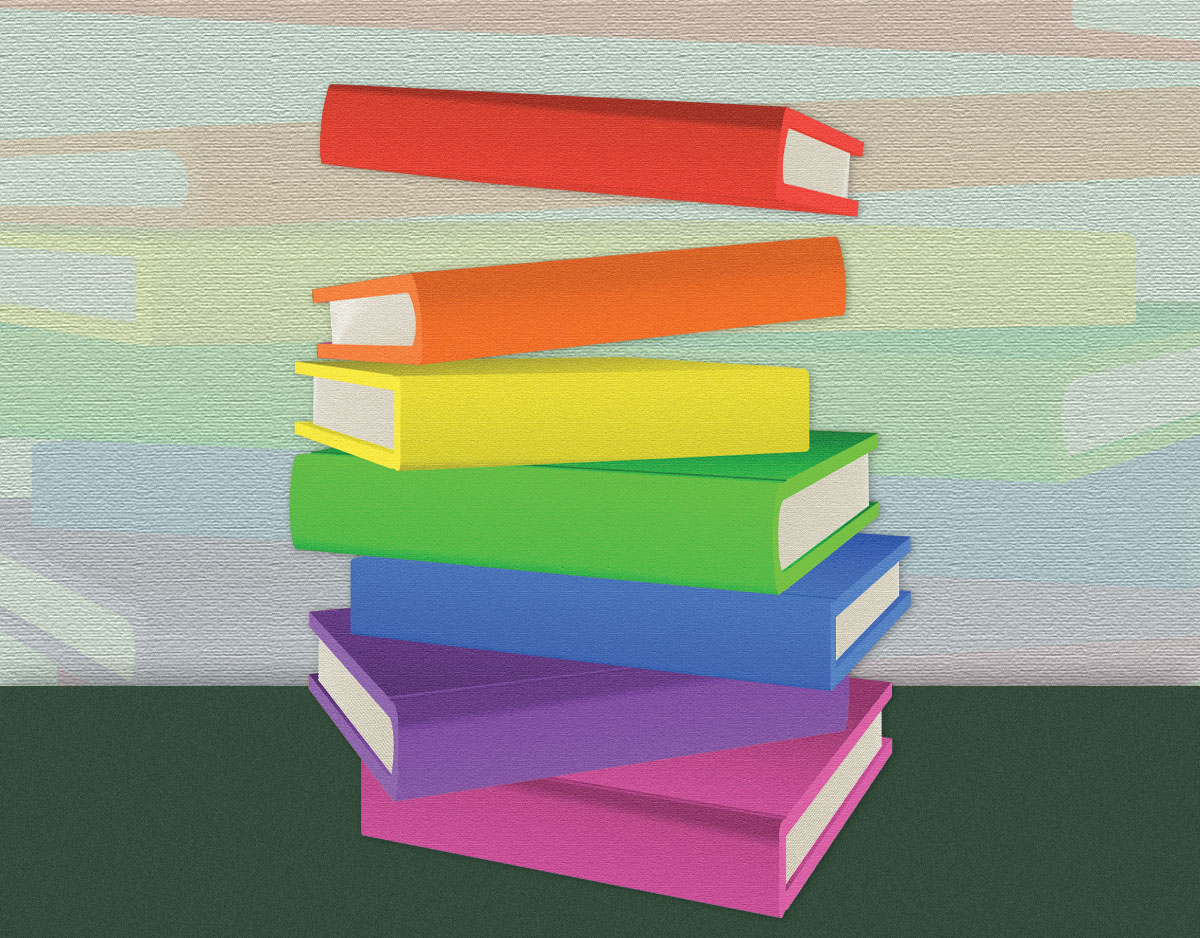A Rainbow Collection: The Day Shelves Got Colorful
When educator Benjamin Ludwig missed one day of school, a group of fifth graders reorganized the books—not by genre, but with ROYGBIV.
 |
Montage by SLJ. Source art: Getty Images |
I was out for one day. One.
It was my final year as a fifth to eighth grade language arts teacher. I was studying to become a library media specialist, and the class I was taking at the time was Cataloging and Curation. I had call numbers, genres, and access on my mind.
Inspired, I decided to have my seventh and eighth graders genrefy our classroom library, which was previously organized only in terms of fiction, nonfiction, and poetry.
It would take us four days, or four classes, to sort the books into genres. From the very start, the kids did a great job and had some important discussions about genre. What’s the difference between Adventure books and General Fiction? Should there be a Romance section? Is YA always characterized by romantic elements? In addition to these ongoing conversations and decision-making sessions, I did a lot of weeding.
There was a student in my homeroom, a fifth grader I will call Aria. Artsy and supremely talented, she was always sketching in her notebook, coloring, and cutting shapes from colored paper. She was also the unofficial class leader. If Aria said the class was going to play Museum during recess, the class played Museum. If she said it was time for quiet reading, then that’s what they did.
She let me know that the younger students were jealous that their older counterparts had been involved in organizing the classroom library. Aria further remarked that the newly organized books looked boring. She liked the way books looked in our local bookstore, with forward-facing covers and stacks artfully arranged on tables.
On the fourth and final day of sorting the books into separate piles, which happened to be a Friday, I let the students know that I’d be out on Monday. One day.
“Don’t touch the books, please,” I told all my classes. “They’re grouped and piled according to genre. We’ll alphabetize and get them on shelves when I return.”
Monday came and went. I returned to school the next day to find a note on my door. It read, “We fixed the books!” The handwriting was unmistakably Aria’s.
When I walked in, I immediately saw that the books were no longer on the counter. They were on the shelves and, from my distant vantage point, the sight was somehow beautiful.
But how had the students alphabetized the books so quickly in so little time? Each class was only 55 minutes, and I’d left multiple reading and writing assignments. Instantly, I imagined students in all four grade levels working together, placing the circle stickers I’d purchased to mark fiction, nonfiction, and poetry on the book spines. I imagined older students helping younger students. But I hadn’t told anyone where the stickers were, and they weren’t easy to find—behind the highlighters and boxes of dry-erase markers in the closet. Maybe they’d gone exploring and found them on their own?
As I walked toward the books, I marveled at how nice they looked on the shelves. The colors seemed to flow together like a rainbow.
A rainbow? Sure enough, there were red books on the far left, yellow followed by green, then blue in the middle, and purple on the far right.
They’d organized the entire classroom library—upwards of 2,500 books—according to the visible spectrum: Red, Orange, Yellow, Green, Blue, Indigo, Violet (ROYGBIV). The black, gray, and white books were on a separate shelf at the front of the room. There were no stickers anywhere.
All four days of sorting had been undone in one 55-minute class period by a single class of fifth graders, led by Aria, whose artistic sensibility demanded a different kind of order—one that she’d imposed with perfect ROYGBIV precision.
Every staff member had an opinion. The social studies teacher was impressed by the different perspective. The math teacher couldn’t understand why we weren’t using the Dewey Decimal System. The science teacher, who openly admits he doesn’t like to read, was proud that his students remembered the correct order of ROYGBIV.
And me? I went through a range of emotions. First I was surprised, then mad. But the anger was short-lived, replaced by a feeling of dumbfoundedness. Finally, I was just plain worried, because I had to tell Aria and her class that this new system wasn’t going to work, and the older students, who worked so hard to organize the books by genre, would have a fit.
Then Aria herself arrived. Instead of waiting for me to act surprised and pleased, she had questions.
The biggest had to do with the tan books, she explained. Is tan closer to white or brown? Where does brown fall on the spectrum? These are important things to consider, and they led us to Google. Turns out brown falls between red and orange. Even so, Aria explained, a very light tan can seem off-white. So does it belong with the white books or with the brown?
These questions were so interesting—downright exciting—that I let the rainbow stand, and we continued our discussion into the week.
Meanwhile, one of Aria’s friends tried to find a copy of The Witches by Roald Dahl (yellow) and couldn’t find it anywhere. Another wanted The Hunger Games (black). Though several friends had a vague memory of the cover being darkish, they had to look it up on Amazon to settle the dispute.
Eventually Aria figured out that organizing by color wasn’t the most efficient system for finding books. She decided that organizing in terms of “what they’re about”—her way of expressing genre— would be better. We arranged to have her work with the seventh and eighth graders to reorganize the books from scratch. They were furious at first, but when they saw how sincere Aria was in her desire to create a usable system, most of them came around.
In the end, I realized that any organizational structure imposed upon a set of books—or anything else—poses challenges, all of which require an inquiry approach to resolve. It’s important to differentiate between inquiry and research here. Research is the process of finding a specific answer—the answer, as it were. Inquiry is the process of asking questions to plumb greater depths. Or better, how a circle of questions can reveal different perspectives on a given topic.
Research could never yield a universal solution to the problem of organizing a library, because different communities have different organizational needs and preferences. Inquiry, on the other hand, allowed Aria to understand that there are different ways to do things. She learned that there are decisions she herself would have to make, and that as long as she gathered enough information, she had every right to make them. She learned color theory, too.
Sometimes a teacher’s job is to make lemonade out of lemons, or in this case, let a rainbow grow from what otherwise might have been a functional (and uninspired) paint-by-numbers. Ultimately, the systems of organization we adopt, choose, or invent are reflections of ourselves. As a new librarian at a new school, I think a genrefied collection driven by student input is probably the way to go. I don’t know if it will ever have quite the same visual impact as Aria’s library. But I do hope that it will inspire the same level of inquiry.
Benjamin Ludwig is a K–8 librarian in New Hampshire and a novelist.
RELATED
The job outlook in 2030: Librarians will be in demand
The job outlook in 2030: Librarians will be in demand
ALREADY A SUBSCRIBER? LOG IN
We are currently offering this content for free. Sign up now to activate your personal profile, where you can save articles for future viewing






Add Comment :-
Be the first reader to comment.
Comment Policy:
Comment should not be empty !!!